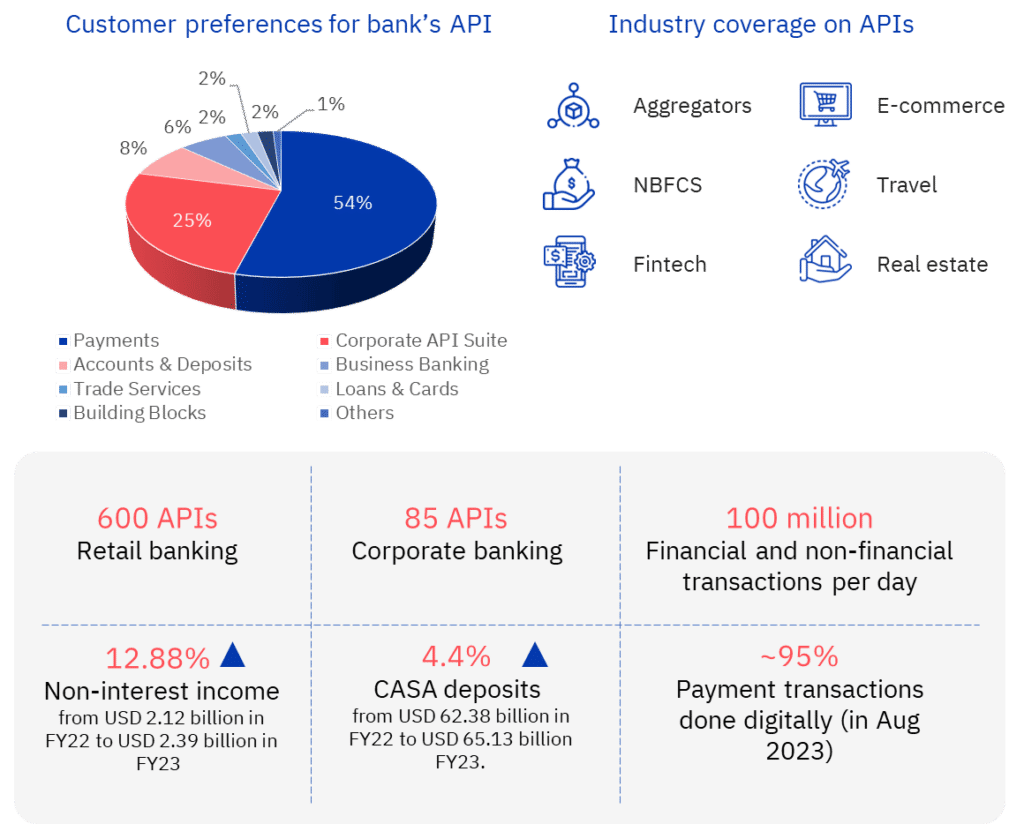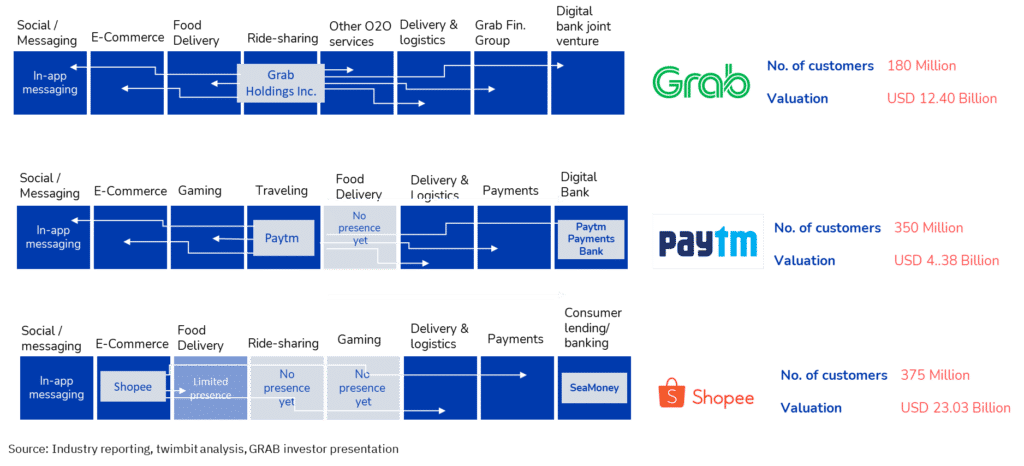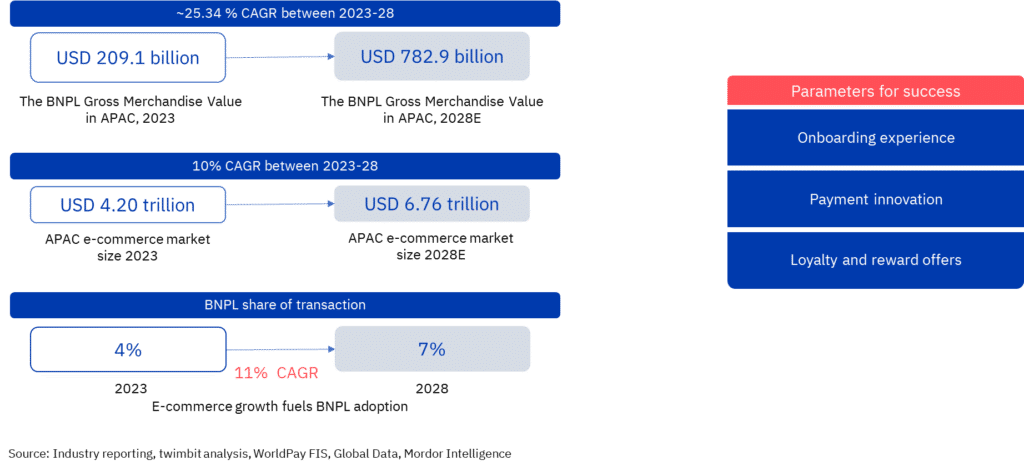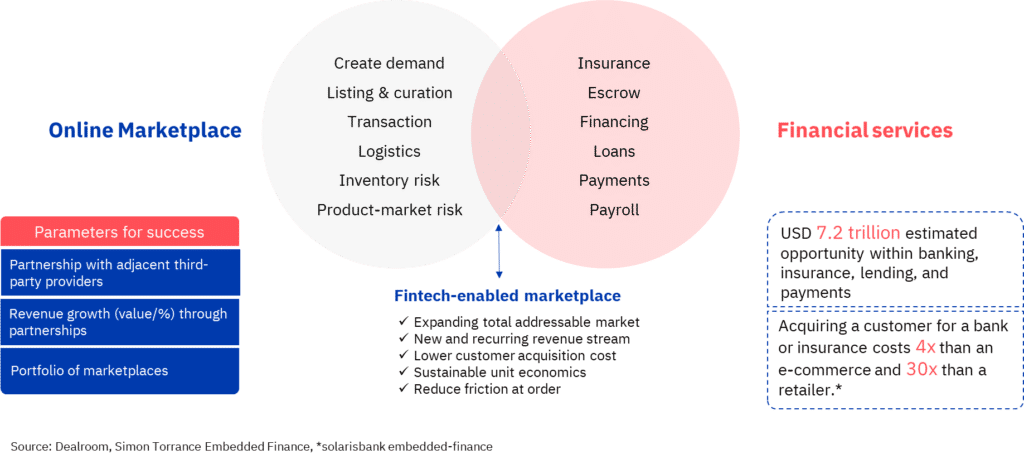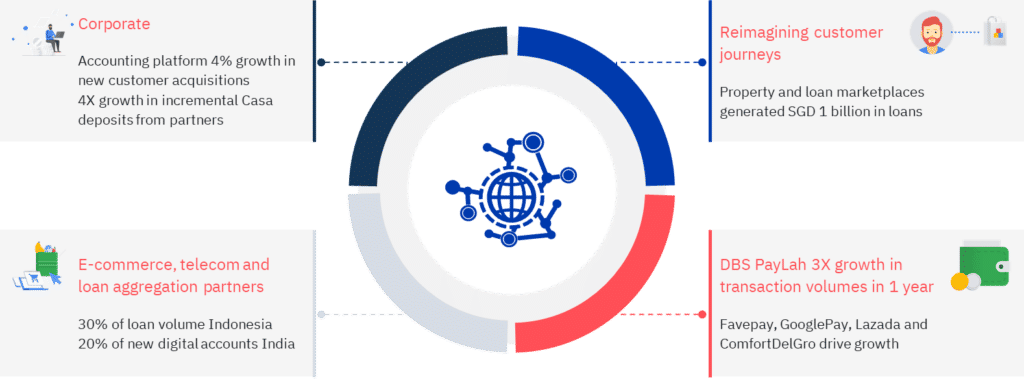Overview
APAC banks are experiencing a paradigm shift from expanding interest incomes to exploring growth with non-interest fee-based income.
The pressure to maintain operational sustainability, lower the cost to-serve, and growing CASA balances fuel the banks to innovate and expand their portfolios beyond core banking.
Rise of platform banking models and digitalization challenges banks to find new ways to capture wallet share.
Orchestrating exceptional customer experience with invisible banking will enable banks to acquire, retain, and sustain long-term customer relationships.
The 5 biggest growth adjacencies for banks in the region include:
- Banking-as-a-service (BaaS)
- SUPERAPPs
- Data Monetization
- Financial Marketplaces
- Buy Now Pay Later (BNPL)
Digital economy drivers
Digital adjacencies will contribute over 40% of the banking revenue by 2030
- The non-interest income contribution to revenue for leading APAC banks such as SCB and OCBC is at 26% and 30% respectively as of 3QFY23
- Average annual CASA growth of 10%-12% as of 2023
- USD 198.2 billion BNPL Gross Merchandise Value in APAC 2023
- Asia-Pacific’s Embedded Finance industry is expected to grow by 24.4% annually to reach USD 357,000 million in 2029
- 117.6 billion Unified Payment Interface (UPI) transactions (volume) processed in India in 2023
- APAC digital payment market is expected to grow from USD12.29 trillion in 2023 to USD22.97 trillion by 2028.
14% of APAC bank revenue stems from fee-based income
- Philippines banks have witnessed 30% growth in their fee-based income in a year
5 growth opportunities for banks to be digital leaders of tomorrow
#1 BaaS
Opportunity for license holders to become providers of white label and co-branded products and services.
Enables a plug and play approach for banking solutions into third party ecosystems, including non-finance digital brands, reducing the cost to serve and the cost of customer acquisition.
Building blocks of BaaS
- The top layer of the BaaS stack is a digital ecosystem of financial and non-financial brands.
The user interface and the digital elements integrated with the BaaS layer to control over the:- Customer experience
- Branding
- Personalization
- Front-end user interface
- The middle layer in a BaaS stack is the API marketplace which provides specialised financial services solutions to brands in the digital ecosystem
- The bottom layer is where banks, fintech partners and third-party service provider offer their financial solutions to the end user through modern APIs
Top 3 banks acing BaaS model
- The bank has a suite of 600+ APIs
- An API banking portal for developers to build, test and integrate new APIs across banking product categories.
- Bank witnessed an increase in their fee income by 14.28% from USD 1.90 billion to USD 2.16 billion from 2022 to 2023.
- The bank has a suite of 200+ APIs
- DBS API developer platform is well-positioned to embed services on partners’ platforms to acquire and distribute at scale.
- Net fee and commission income of DBS accounts to 16.55% (USD 2517 million) of total income (USD 15.2 billion) till 9MQ3 2023
- The bank has a suite of 500 APIs
- Implemented a host of embedded finance solutions for the education, energy, government, and insurance sectors to streamline KYC and payments.
- Generated USD 336.53 million from their fees and commission in 3Q23
Case-in-point
ICICI established an API ecosystem for core and SME banking
ICICI Bank is at the forefront of building a robust third-party API platform. The focus on BaaS has significantly transformed the banking landscape for ICICI Bank in the country.
The portal incorporates a detailed workflow for conveniently moving the API solution to the final production stage, thereby eliminating the hassles of manual to and fro.
Imperatives for success
- A safe and secure mechanism to support customer journey transformation
- Enhance customer experience by integrating systems with third-party providers.
- Enable a wider range of services with features such as account aggregation, payment processing, and lending.
- Provide future-proof security features, such as authentication, authorization, and encryption, to ensure that customer data is protected.
- Developer platforms and sandboxes to support agile innovation
- Build an (API) sandbox as a closed IT environment designed to experiment safely with new solutions – with lots of flexibility, irrespective of governing regulations.
- Provide an environment for innovative fintechs and financial institutions to recreate a productive environment and simulate the responses from the systems it communicates with.
- Create and test external developments, completely isolated from the bank’s production environment.
- Identify any anomalies, risks, and conflicts of interest before exposing the product to the public.
- An agile and flexible Open Banking architecture to support partnerships at scale
- Allow fintechs to manipulate the Standard terms of the data base to build service offerings, including mobile payment applications, peer-to-peer lending solutions, and analytical dashboards.
- Generate revenue by allowing fintechs and third-parties to monetize their APIs through developer portals, usage analytics, and revenue-sharing models.
#2 SUPERAPPs
Enable users to access multiple services without leaving the app, leading to higher user engagement and retention.
Integrate multiple services into one platform.
Save costs associated with customer acquisition and operational costs, leading to improved profitability.
SUPERAPPs opportunities
- 65% of APAC GDP will be digitalized, reaching USD 1.5 Trillion in customer spending by 2025
- E commerce market is growing with a CAGR of 10% in the forecast period of 2024 to 2029 and is expected to reach USD 6.76 Trillion by 2029
- APAC witnessed USD 4 Trillion worth of digitally deliverable services trade in 2023
- The ASEAN SUPERAPP market is currently worth ~USD4 billion in revenue with a growth projection to be USD23 billion by 2025.
Top 3 companies acing SUPERAPPS model
Case-in-Point
How super features made Paytm a SUPERAPP
Paytm is an Indian digital payment and financial services company
Paytm offers a variety of services, including
- Digital payments
- Mobile recharges
- Bill payments
- Travel bookings
- Digital wallet
- Financial services
- E-commerce platform
- Paytm mall
Paytm is taking advantage of a large payments data to introduce new products and services to serve end to end customer needs. The third-party APIs help conveniently implement finance value propositions to service multiple customer journeys such as utility management, travel, entertainment, lifestyle.
Imperatives for success
- Build an AI and ML- driven bank
- Understand users’ behavior and preferences to create personalized recommendations and services. This helps to increase customer engagement and loyalty.
- Analyze user data, make predictions, and suggest products or services that are most likely to be of interest to the customer.
- Predict equipment failures and schedule maintenance proactively, reducing downtime and improving service quality.
- Create an agile cloud infrastructure
- Provide on-demand scalability to handle traffic spikes and support user growth without significant upfront infrastructure investment.
- Facilitate the adoption of DevOps practices to deploy new features quickly, collaborate more effectively, and improve application quality.
- Ensure robust security features, such as encryption, access controls, and threat detection that are secure and compliant with industry standards and regulations.
- Design microservices architecture
- Allow SUPERAPPs to add new features, update existing ones, and scale individual services independently without affecting the entire system.
- Enable quick responses to changing customer needs and market demands.
- Reduce operational costs by allowing SUPERAPPs to use different technologies, languages, and frameworks for individual services, reducing infrastructure and licensing costs.
#3 Data monetisation
Leverages the treasure trove of information to address customer needs and provide actionable insights to help unlock value.
Business models include providing raw data as a service, actionable insights generated from data or supporting outcomes, such as KYC, fraud management, and other innovative services.
Data monetisation opportunities
- Banks are custodians of massive amounts of customer data and have an invaluable opportunity to build customized value propositions for their customers.
- Financial institutions can utilize the data to generate insights on customer behavior and understand how macroeconomic factors impact saving and spending patterns in creating hyper-personalized value propositions.
- Third-party providers benefit significantly from using customer data and combining it with datasets such as social media interactions, digital IDs, and geographical data to develop compelling customer solutions
Case-in-point
Bank BRI creates a robust financial inclusion framework with data monetisation
- Bank BRI is a large Indonesian bank. They created new business opportunities using APIs as Bank BRI saw a huge opportunity in micro-financing.
- They created a mobile app powered by Apigee, Maps API, and Vision API for people to Self-ID themselves, check credit score, request for a loan, and get instant disbursement.
- Bank BRI also enabled fintechs with the capability to conduct credit scoring via its APIs.
Imperatives for success
- Big Data Analytics
- Use big data analytics to process and analyse large volumes of customer data to identify monetisable patterns, trends, and insights.
- Leverage big data analytics to offer data-driven products and services, such as personalized recommendations and insights for their customers.
- Data Privacy and Security Framework
- Implement robust data privacy and security measures to protect sensitive data and prevent unauthorized access.
- Ensure data is secure and compliant with regulatory requirements, such as GDPR, CCPA, CDR and other data protection regulations.
- Blockchain Technology
- Securely share data with partners and customers while ensuring data privacy and security.
- Enable the adoption of multiple API standards
- Streamline processes to reduce costs and improve transparency
#4 BNPL
BNPL will likely increase the spending and lending volumes for retail banking.
BNPL will likely trigger additional services around cash management for business banking.
Banks can proactively create offers and manage real-time personalization of both in-store and e-commerce purchases.
Buy Now Pay Later (BNPL) opportunities
Top 3 companies acing BNPL model
Case-in-point
Klarna unlocks value with convenience, personalized incentives and intuitive CX
- Klarna, a Swedish fintech company, has become a leader in the “Buy Now, Pay Later” (BNPL) space. Klarna’s BNPL options include:
- Pay in 3: Split the purchase into three interest-free installments.
- Pay in 30 days: Delay the full payment for 30 days without interest.
- Financing: Pay for larger purchases in monthly installments with interest.
- Klarna sets itself apart with a smooth user experience via its user-friendly app and seamless online store integration. Emphasizing mobile shopping, it targets younger generations through effective marketing campaigns. Strategic partnerships with major retailers like H&M and IKEA further extend its reach and value proposition.
- Klarna also collaborated with OpenAI to enhance the shopping experience on ChatGPT.
- Klarna’s curated product recommendations will be integrated into ChatGPT, providing personalized shopping advice and links to shop through Klarna’s search and compare tool.
Imperatives for success
- Use business intelligence to customise BNPL offerings
- Use data analytics and business intelligence tools to gain insights into customer behavior and preferences
- Create targeted BNPL solutions that meet customer needs
- Improve the effectiveness of the BNPL offerings by embedding into customer journeys such as e-commerce, utilities, travel etc.
- Leverage API banking to embed peer ecosystems
- Use open banking standards to securely share customer data with third-party providers, enabling them to offer innovative BNPL solutions
- Partner with fintech companies and other third-party providers to expand BNPL offerings
- Create predictive credit models with AI
- Use AI and ML to assess customer risk and determine creditworthiness
- Leverage AI and ML to improve the accuracy of their credit assessments, reduce the risk of default, and increase the revenue
- Offer personalised installment plans with the right interest rates and repayment periods
#5 Marketplace
Opportunity to leverage proven, trustworthy, Salesforce retail banking features using products backed by your bank’s credibility is a step toward meeting new customers.
Banking marketplace offers to strengthen and leverage relationships can bring your financial institution a customer’s lifetime value.
Opportunities for marketplace
Top 3 banks acing the marketplace model
- DBS marketplace allows consumers to buy or rent property, book flights or hotels, switch their electricity supplier, or buy or sell a car.
- DBS launched its first fully digital Fixed Income Execution marketplace and executed over 80 trades, amounting to USD 11.93 billion in FY22
- Non-interest income grew by 11% to USD 2.96 billion in Q3FY23
- Bajaj Finserce has diversified Financial Services & e-Commerce Open Architecture Marketplace offering Loans, Cards, Insurance, Investments, Payments &Lifestyle products in partnership with 37 Banks, Insurers & Financial Institutions
- Offering 1300+ Financial products and thousands of Lifestyle SKU’s on its Bajaj MARKETS platform
- Bajaj Markets recorded a revenue of USD 47.02 million in FY2023
- OCBC’s OneAdvisor Home provides all the tools and resources that property buyers would need to make an informed purchase – from property listings, policy details, rules and regulations to affordability advice.
- The portal allows consumers to apply for home and renovation loans with home loan approval in 60 minutes
Case-in-point
DBS grows by reimaging customer journeys through marketplaces
Imperatives for success
- Harnessing blockchain for secure and transparent marketplace services
- Banks can use blockchain technology to securely and efficiently process transactions on their marketplace platform, reducing the risk of fraud and increasing transparency.
- By leveraging blockchain, banks can offer more secure and reliable marketplace services, driving customer trust and loyalty.
- Leveraging open banking for expanded marketplace offerings
- Banks can use open banking standards to securely share customer data with third-party providers, enabling them to offer a wider range of financial products and services through the bank’s marketplace platform.
- By partnering with fintech companies and other third-party providers, banks can expand their marketplace offerings and revenue streams.
- APIs to fuel marketplace diversity
- Banks can leverage APIs to connect with third-party service providers, enabling them to offer a diverse range of products and services within their marketplace.
- APIs facilitate the integration of various systems and data sources, allowing customers to access a broader range of financial services.

















